Wakefield Show 2021
A summary of the first and last virtual Wakefield show for those who do not have the time to listen to it in full.
The virtual show theatre presentations are given below:
1030 Anthony Bartram from AMCOG games:
"AMCOG Games will be showcasing our brand new title 'Spy Mission: The Ice Caves of Dr. Atom' which will be available to buy at the PlingStore on the day of the show. The WROCC show talk will also cover RDSP and Development Kit updates as well as a quick look at all 16 games released over the last 6 years."
Anthony said that he had been using RISC OS for seven years and releasing games for six. There is a new game 'Spy Mission: The Ice Caves of Dr Atom' - a sideways scrolling game with a nuclear-powered car.
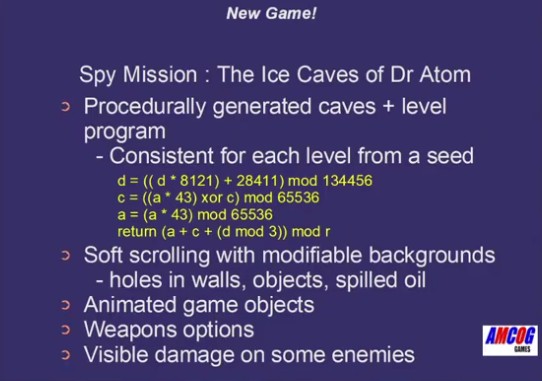
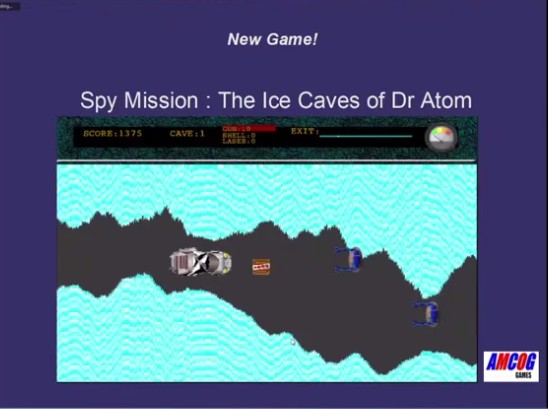

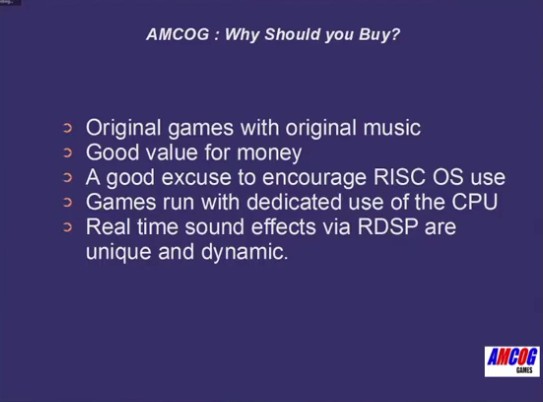
An update to the development kit and an update to the RDSP will be released later this week. RDSP is a 'fantasy sound chip' with lots of channels and many effects.
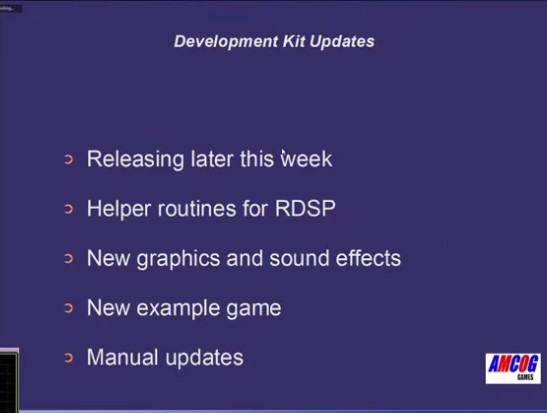
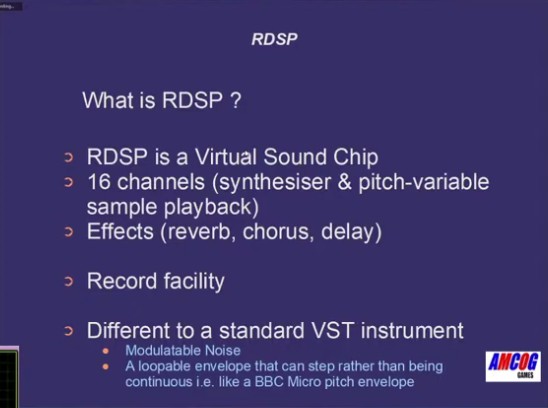
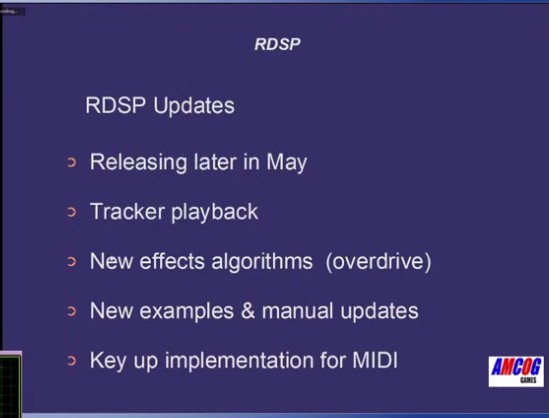
He demonstrated the new game and some of the games already released.
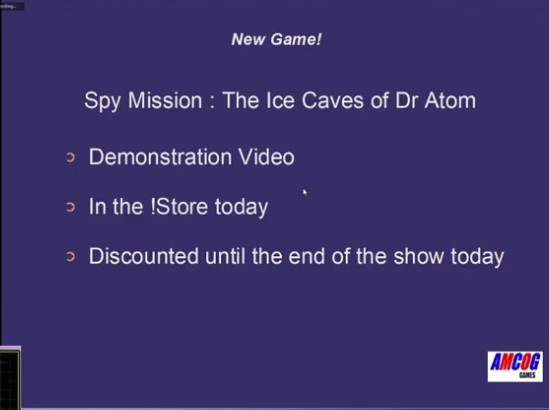
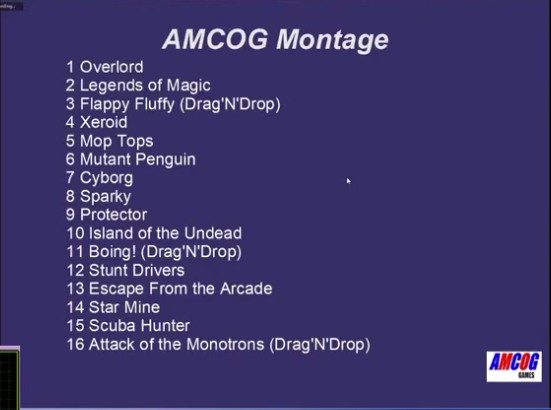
The Q&A session included rotascoping (draw around an object to help animation) and rotating (using library routines). He confirmed source code was included.
1130 RISC OS Developemnts
"RISC OS Developments will be talking about and demonstrating the Iris web browser project, new TCP/IP stack, Pinboard 2 and various other projects."
Andrew Rawnsley explained the various projects upon which ROD were embarked. He recalled the initial focus on the web browser which now extended to ownership of the RISC OS IPR. Improving the user experience was a key task. Starting with a look at the new Pinboard, available for beta test now by a simple e-mail request.
Files and directories can now be saved to the new pinboard and the ability to show a 'link' to a file elsewhere in the form of a pinned object is retained, which now show a 'pin' symbol. Pinned objects can now be 'fixed in place'.
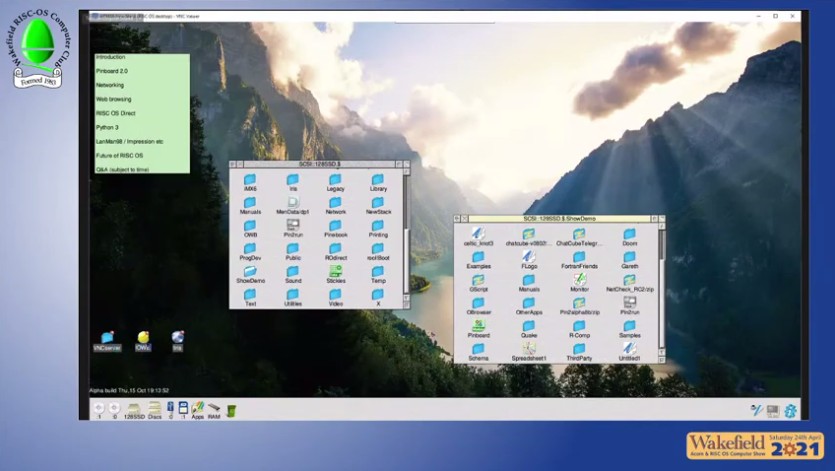
Text notes can now be pinned and he showed his notes for the talk. A new configure plug-in is provided. The background image can now extend below the icon bar so that you can't see all of it. It means artificial scaling is no longer required for an image designed to fit the whole screen.
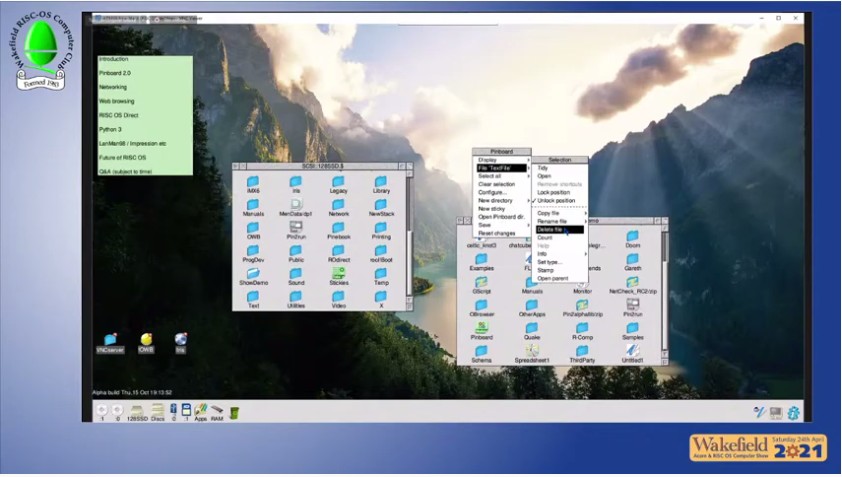
He emphasised that Pinboard 2 was currently a beta release. Where the backdrop was a 'JPEG' image or other 'coded' format, its sprite format would be cahced, speeding up a redraw.
ROD had also tackled networking. A new TCP/IP stack had been developed (without resort to the ROOL bounty scheme) based on a modern open BSD networking stack including elements of IPv4 and IPv6 as well as stack support for WiFi. A beta release awaits completion of work on DHCP but is otherwise complete. The necessary 'messaging' changes are in hand.
As WiFi support is included, only hardware-specific drivers for particular WiFi chips will be needed for this to work.
Drivers for EtherUSB, the ARMX6 (EtherTH) [and the Titanium] were well advanced and one for the Pi4 was making progress. The new stack was not yet optimised for speed but is already faster than the existing stack. The new stack should work with no alterations to exisiting applications, such as LanMan98.
The new IP stack will be offered for open source release in the next few months. The new Resolver module will be (AIUI) backwards compatible.
The new web browser, Iris, now includes a Javascript 'JIT' giving significant performance improvements. Andrew demonstrated this on the 4te. Any purchasers of OBrowser will now find an update to the latest version of Iris. OBrowser is also available on !Store. Technically Iris is available for a donation rather than as a product with full technical support.
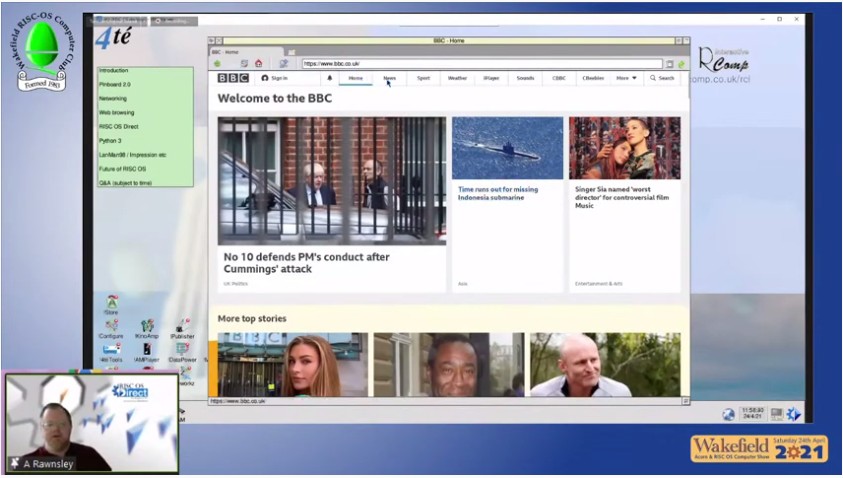
The BBC web site and Google maps and street view were both shown working well. The minimum specification for Iris is an ARMX6 and the extra oomph of a Pi 4 or Titanium is useful. Pi 2 and Pi 3 may also work adequately.
Andrew Rawnsley explained the purpose of the RISC OS Direct distro to attract new users by giving away SD cards at PiJams to anyone expressing genuine interest. It was rather held up by Covid! The distro supports Pi 4 and Pi 400 and will auto-detect networking.
Python 3 is now available via Packman. The 'c' modules do not yet work but pure Python libraries should work. LanMan98 is now open source and is being developed with the goal to extend to more modern protocols - at present it runs on version 1 of the CIFS protocol but the rest of the world is on version 2 or 3. The biggest hurdle relates to the use of Unicode for all text handling, not currently supported by the filer, making translation back and forward necessary.
Work on Impression-X continues, more news later this Summer. Impression Style is freely available offering most of the facilities in the full Impression-X, i.e. apart from irregularly-shaped frames and sophisticated colour handling including CMYK.
Talking about ROD's road map, a big part of the plan has to be the big looming problem of exclusive support for 64 bit. ARM 9 might offer some 32 bit support but may not be provided on most chips. There are two possibilities - a 64bit RISC OS might not have much left of the RISC OS way of doing things nor be able to support existing applications without more work. The other approach is to use a 'shim' layer between RISC OS and the processor. A bare-metal operating system between the CPU and RISC OS may not satisfy purists but experiments show it can support ARMX6 speed. Discussion with ROOL and programmers is under way and this will be a costly and essential project.
Questions included whether Iris included the DOM (it does, allowing Javascript to write to blocks within the page), the JIT is written in Thumb2 and Jeffrey Lee has made this usable on RISC OS and also m-mapped memory. The ROOL bounties remain open and will probably help with the integration of the new work on TCP/IP. There was no news on multi-core - it is on the road map but other projects must currently take precendence such as 64 bit. Some Pi products are committed to support 32 bit for the next 5 years but the clock is ticking.
A question about shared libraries between Python and Iris led to the explanation that the pre-release Iris has its own version of the shared libraries within the application to simplify support but this would be resolved before the public release of Iris.
1230 R-Comp
"R-Comp/RCI will be talking about various software and hardware products, from Fireworkz, to LockScreen to 4te to RISCubes and some surprises, and special offers to those who attend/stay awake!"
Andrew noted that 4te had launched in November 2020 and almost all back orders were now fulfilled. This Pi 4-based computer costs about £200 and is designed to combine software and hardware, either of which would support the pricing alone. The softwear provided supports VPN screen sharing making 'headless' machines easier to use. Dynamic hot-plug networking including ShareFS is included so the machine can be turned on and will work remotely with no user intervention. The Pi-Tools software includes this network functionality on any Pi model.
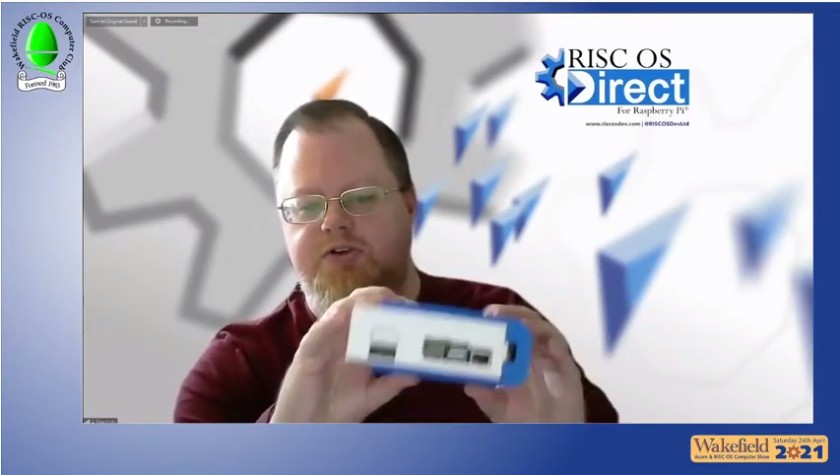
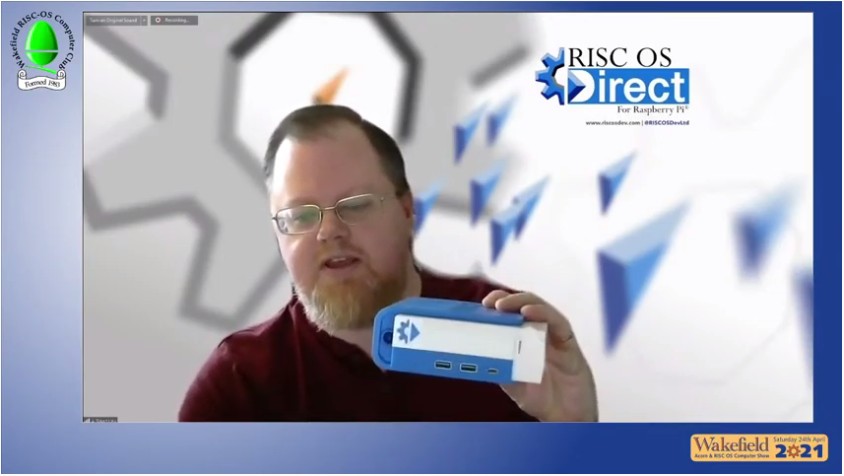
The range of software supplied with the 4te and the storage options were described. The bandwidth of USB 2 provided a limit on data transfer speed whether using USB flash drives or other USB-connected drives such as SSD.
Purchasers of Pi-Tools (available via !Store) will be able to upgrade to the full range of 4te-Tools when the mass-market version of the 'RISC OS Direct Plus' software supplied with the 4te is made available on an SD card designed for the mass market along with an update support scheme. Pricing is not yet finalised but will be in the region of £100 for the £250-worth of software included.
A new project (which Andrew referred to as Nightrider Kit recalling its 'turbo boost') was being developed which should overcome this USB 2 limitation of the Raspberry Pi. This is a 'top end' 4te which uses a custom board onto which a Compute Module 4 is plugged, which offers a PCI Express bus. This should be available in 'the next couple of months'
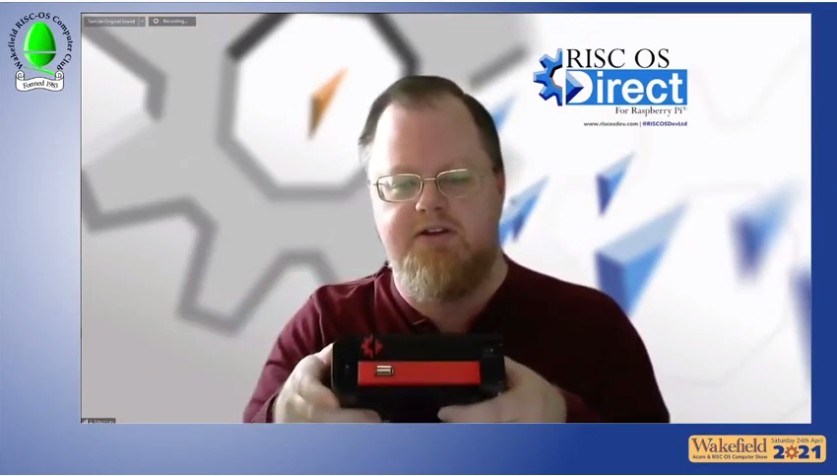
The TiX is a high end system and offers an improvement over a combination of 4te and RISCcube in a single box with two motherboards, Titanium and a 486-based board. Pricing starts at £1500 to £2500 which compares well with the original pricing of a Risc PC. These are built to order and include NDME drive, i7 processor and water cooling.
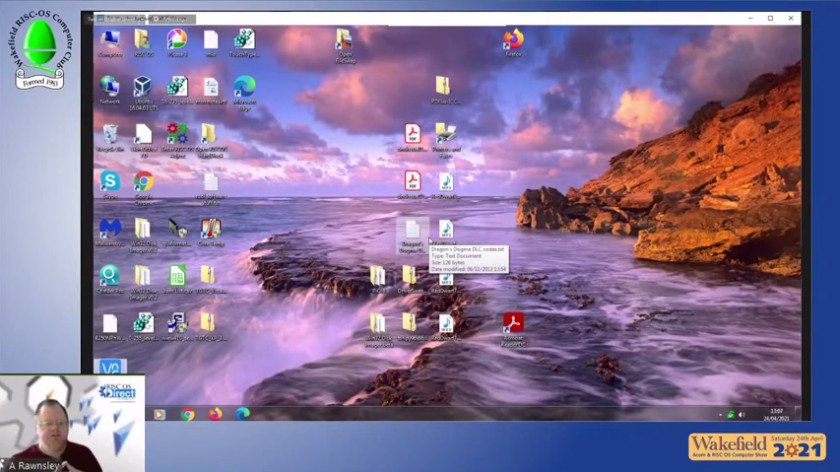
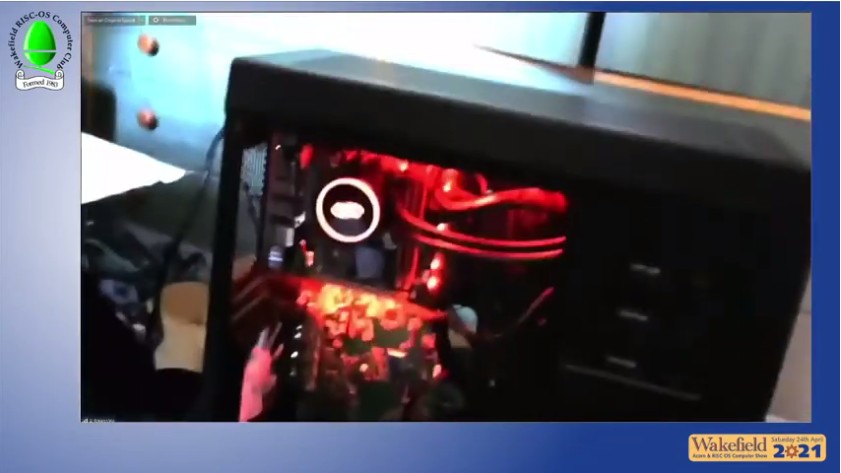
A mini RISC cube, the thickness of a paperback book, includes USB 3.1 and 3.2, a USB-C connection, at a price point depending on requirements, from £500 to £750. Included in the price is a monitor mount kit so the box can be hidden behind the monitor.
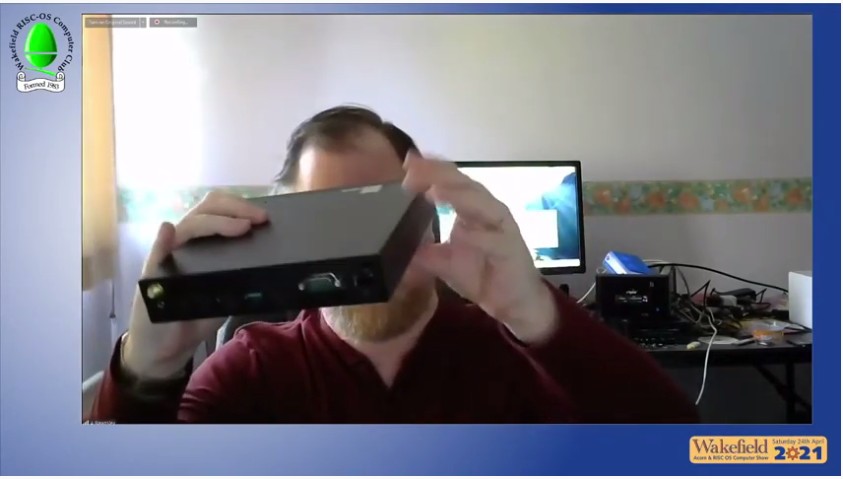
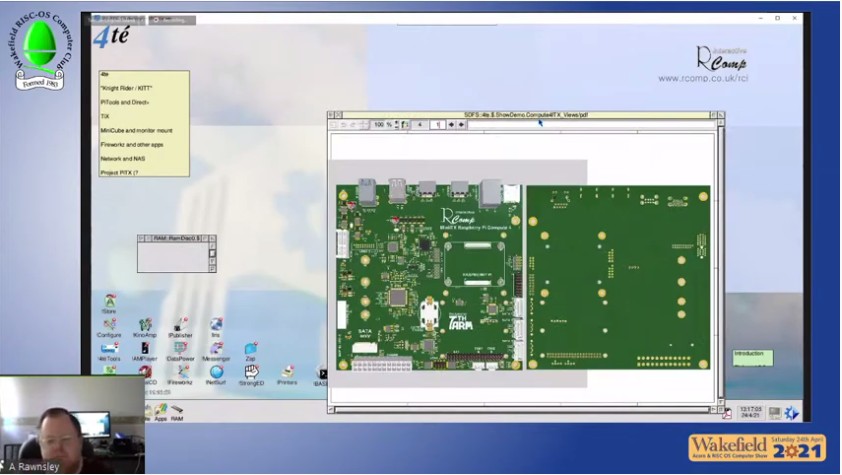
Designing a motherboard is an expensive process. The motherboard is designed but component and production procurement (there are currently shortages) is now the limiting factor. It is therefore several months away despite design being complete.
Concluding with a quick FireWorks Pro demonstartion of dynamic data sharing between applications using the OLE protocol (which also worked on Impression and OvationPro), Andrew showed that a graph embedded in Techwriter (along with its data) could be OLE edited in FireWorks to change the data and re-save the graph in Fireworks.
Improvements to other R-Comp software were also described, including network software. A multi-disc network attached storage (NAS) box was particularly useful now that most users had many devices. QNAP NAS devices offer javascript-based configuration software which runs well in Iris.
1330 Lunch break
1400 RISC OS Open
"ROOL's various achievements and new releases for you to try, launching exciting new bounties, and explaining a bit more about the mid-term roadmap for RISC OS 5"
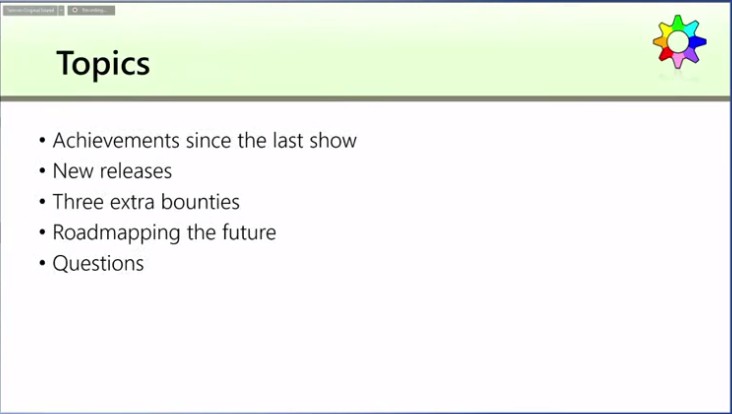
Steve Revill said it had been a fun and challenging year with no let up in progress. A custom build of RISC OS for the Pi 400 was released, which would run on all models of Pi.
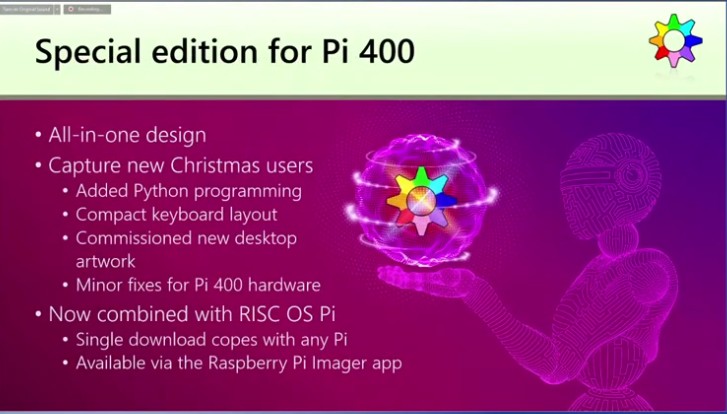
An update to the development tools has also been released.
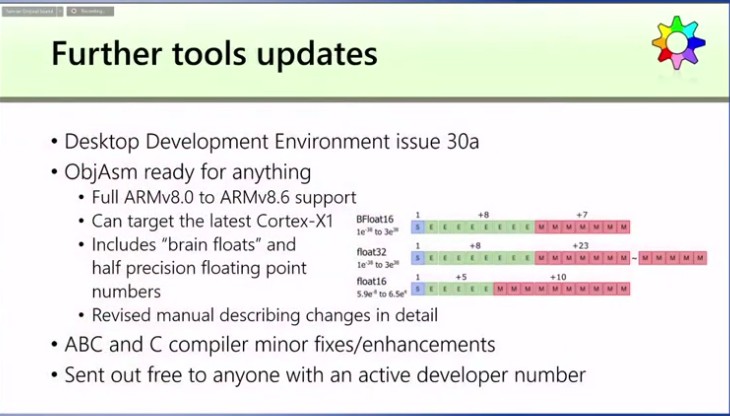
The BBC BASIC manual is now back in print, updated to issue 3 and is also available freely as a digital download from the RISC OS Open web site.
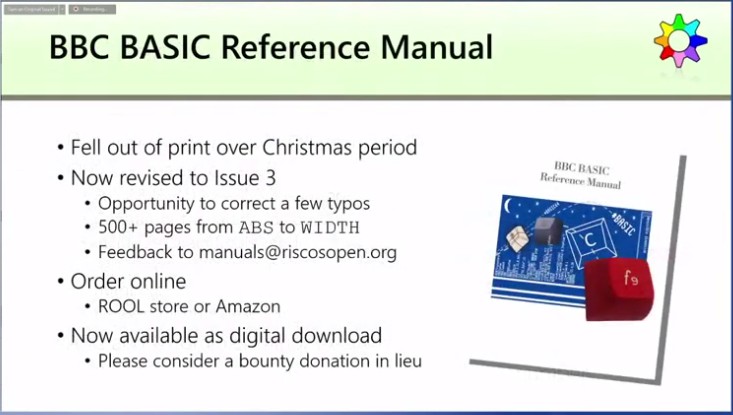
The bounty scheme has now delivered PNG (and JPEG) export from !Paint and !ChangeFSI. Steve demonstrated his artistic talent by modifying a sprite in !Paint and exporting a PNG and JPEG.
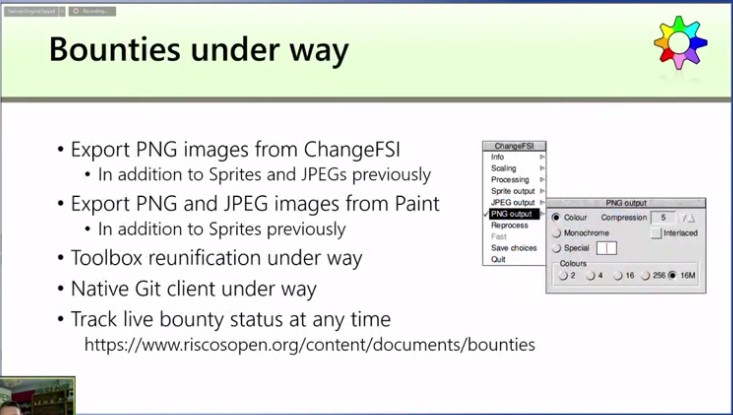
Incorporating the Select scheme improvements in the toolbox and developing a ntive GIT client were both under way.
MoreDesk has been released as open source, previously part of NutPi (now ePIC).
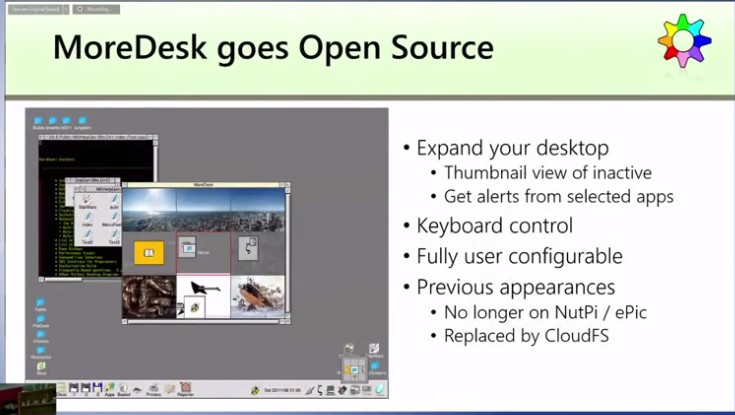
Sample Player is now available again, maintained by ROOL.
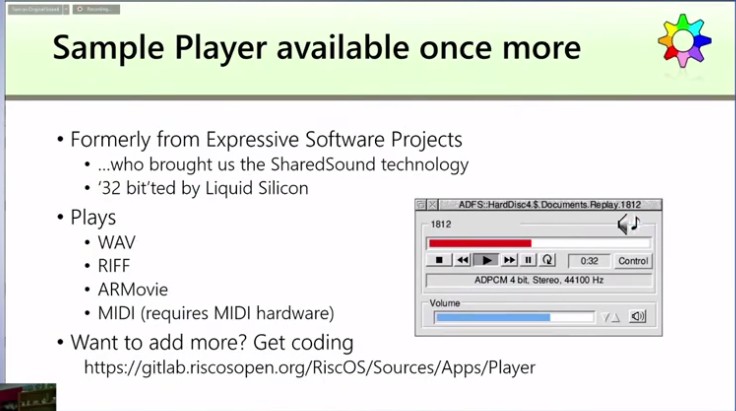
The bounty scheme has sponsored some worthwhile developments. Two bounties failed to connect a developer to the bounty but the functionality was delivered through another route and the money was transferred to another topic.
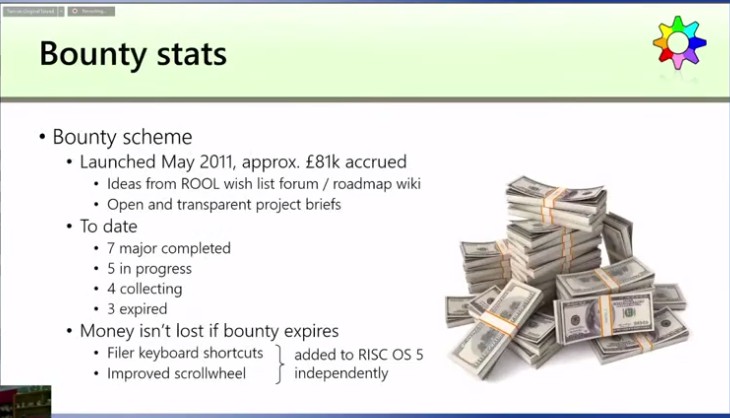
The 'decade of bounties' can be seen in better detail on the ROOL web site as a news item.
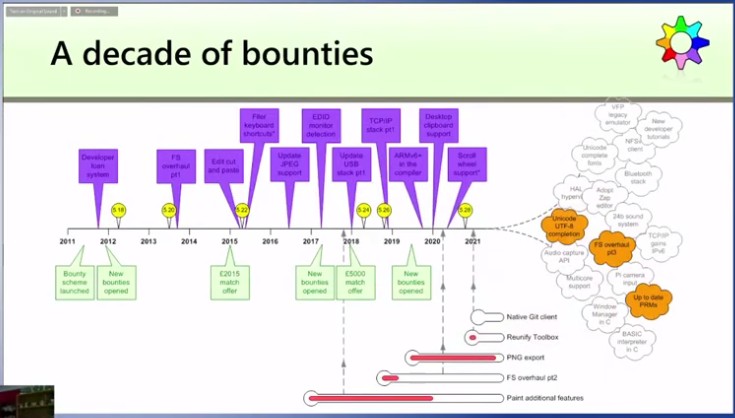
Unicode support is still 'work in progress' as English is said 'not to be the only language'.
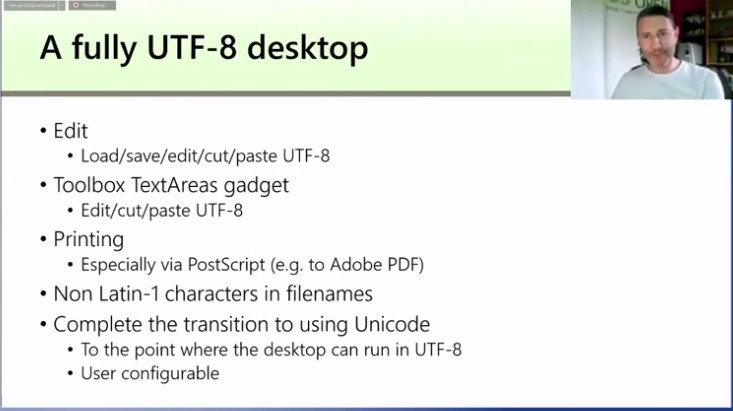
Filing system overhaul (part 3) is another bounty which will be relased soon for contributions.
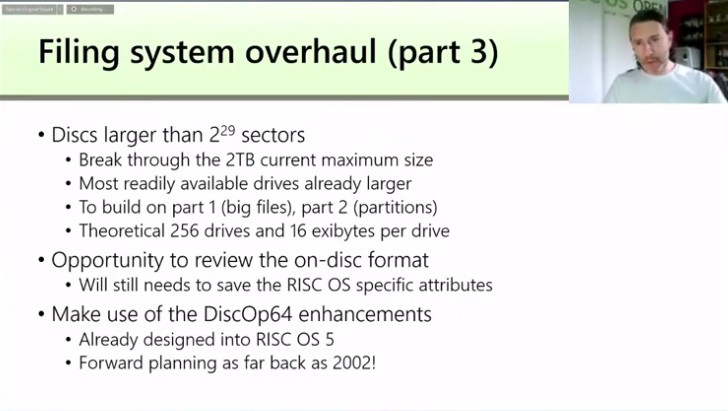
A bounty to update the Programmers' Reference Manuals will be under way now. This is a mammoth task.
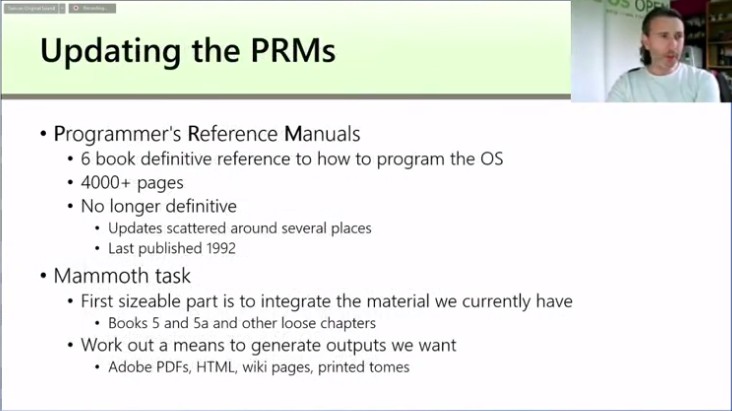
Looking to the future there are some big topics. There are regular meetings with ROD and programmers.
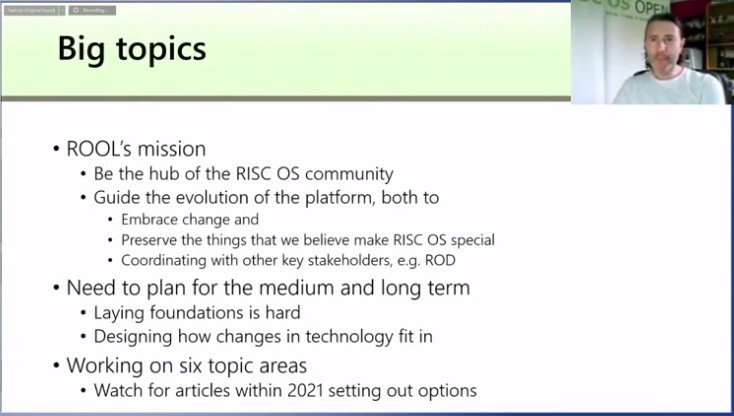
The six main topic areas include supporting more RAM, extensions to data structures in BBC BASIC, moving from 32 bit to 64 bit which will soon be unavoidable.
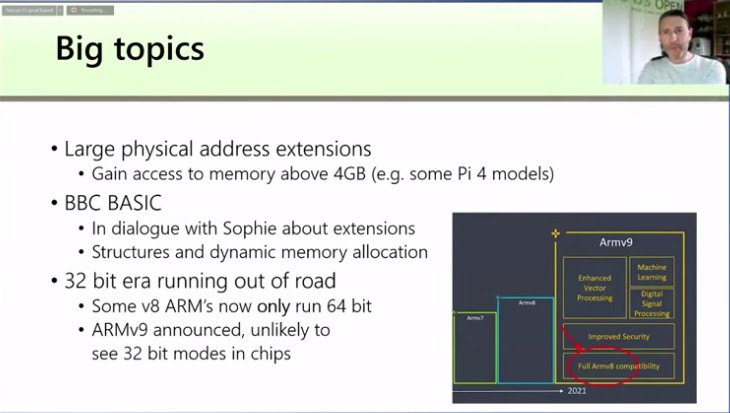
Multi-core support is making progress. Multiple monitors are now supported by several RISC OS hardware platforms and native support within the OS is desirable. Vector floating point support would also offer worthwhile improvements.
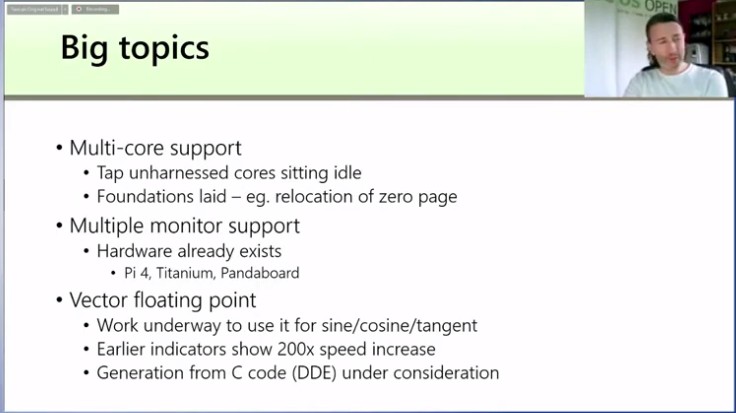
In response to a detailed question on VFP, Steve said that writing of code had started and suggested further discussion took place off line. Rob confirmed that code checking routines were being developed, involving interesting mathematics.
Steve noted that the file system (part 2) bounty had not moved forward but the programmer was currently otherwise occupied but would return to this. Its original scope had also changed to focus on rewriting in C.
The inability of CM4 (under RISC OS) to talk to the on-board eMMc memory (which uses an 8 bit bus and eMMc version 2) and the 3 out of 4 freezing of the mouse pointer on start up of the Lite models of CM4 were raised. Rob asked that this be raised as a Bug on the Forums so that ROOL could raise a relevant item on the bug tracker. The former item has now been done. Rob explained that early access to CM4 as samples had not been available.
The idea of a friendly GUI-based GIT client was also raised. It was confirmed that screensave could now save as JPEG or PNG as well as sprite. Some bounties were open but incomplete but this reflected the limited number of RISC OS developers.
Rob said that the underlying module CompressPNG would offer a simple way to add PNG support to existing applications such as ArtWorks, including support for alpha belending and masking in the module.
Rob asked whether the orange thought bubbles were aspirational or definite targets. Steve said that the thought bubbles were a combination of ROOL wish list and suggestions from users and developers. It was best thought of as the 'idea car park'.
USB 3 development is an open bounty and NetBSD had moved on since then. The timescale was not clear. Now that RISC OS was under the Apache licence, different distros could be produced by different entities and made available. ROOL's role was now one of co-operative coordination.
On the question of individual developements being 'adopted' by ROOL the simplest approach was to use the ROOL GITlab server. Steve said MoreDesk would also be hosted this way in due course and its Pinboard incompatabilities addressed.
The User Guide (and PRM) font licensing is restricted to publication by ROOL and extending this to a more permissive licence is not a priority for ROOL. A bounty was suggested to address this and the likely cost was a few hundreds of pounds. This was supported as a popular idea. ROOL would also be receptive to requests from intending publishers.
1500 Sine Nomine Software
"Matthew Phillips will be demonstrating the forthcoming RiscOSM version 2.00 and will give an update on other software developments since the London Show."
Matthew Phillips noted that some disagreements between RiscOSM ans the VNC client might interrupt the presentation. The new version of RiscOSM 2.00 incorporated a change to the data format (the new format and the old format would load in 2.00 but earlier versions could not load the new format).
For a while RiscOSM has supported certain Wimp messages allowing information to be sent to RiscOSM and the protocol would be uploaded shortly. Some software for GPS trackers using the mobile network to transmit information had been developed, the units were the size of a matchbox and include a SIM acrd. Every few minutes they would say where they were.
Two users were currently moving and their position was demonstrated shown in RiscOSM, being received by a simple BASIC application via the network and messaged to RiscOSM. As they moved apart Matthew zoomed out the map view to avoid jumping between the two points. Each track was set to record and thus started generating a '.gpx' file.
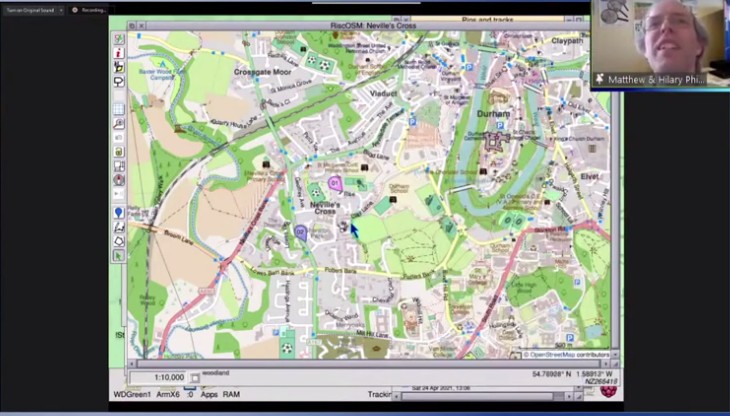
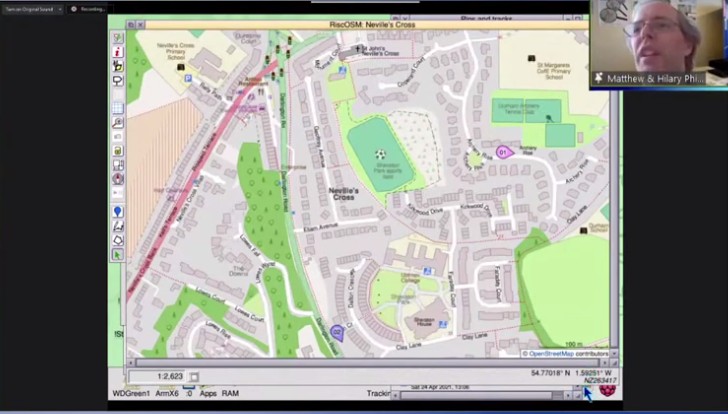
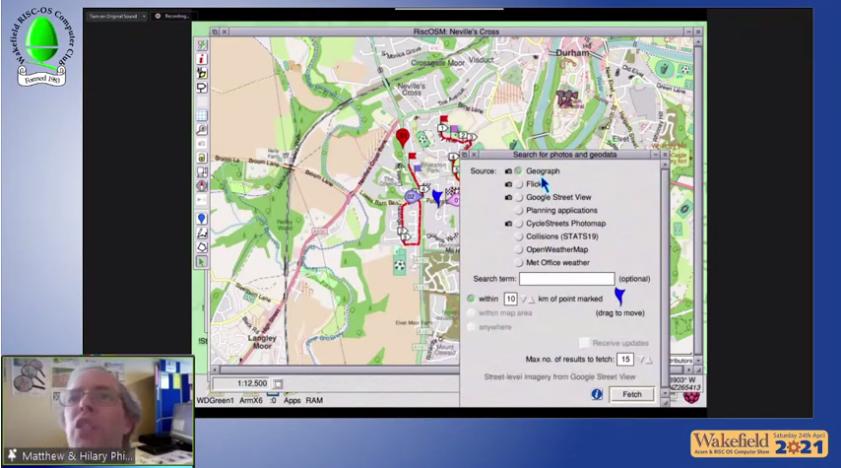
The pins and tracks window now allowed a 'Find' which would search the descriptions as well as the titles. The found items could be added, shown on their own or shown with no map.
The main improvement in RiscOSM 2.00, a chargeable upgrade, was the speed of drawing a small scale map, i.e. one covering a large area. At such scales, many of the smaller or detailed objects are invisible - if the data are structured then such objects can be avoided. Avoiding items that had a very small area being loaded also speeded up loading. As an example, a 1:2,000,000 map centred on Nottingham now loaded in ½ minutes instead of 7½ minutes.
The smallest permitted scale has now been increased from 1:2,000,000 to 1:8,000,000 and at the largest scale the whole of Britain can be displayed in one window. Exporting tracks as a '.csv' file, with the columns selected from a list of possibilities.
The application Recce now allows weather forecasts to be shown - this is also a chargeable upgrade. The data can be exported as either '.csv' or as a Draw file. This also uses the messaging protocol referred to earlier.
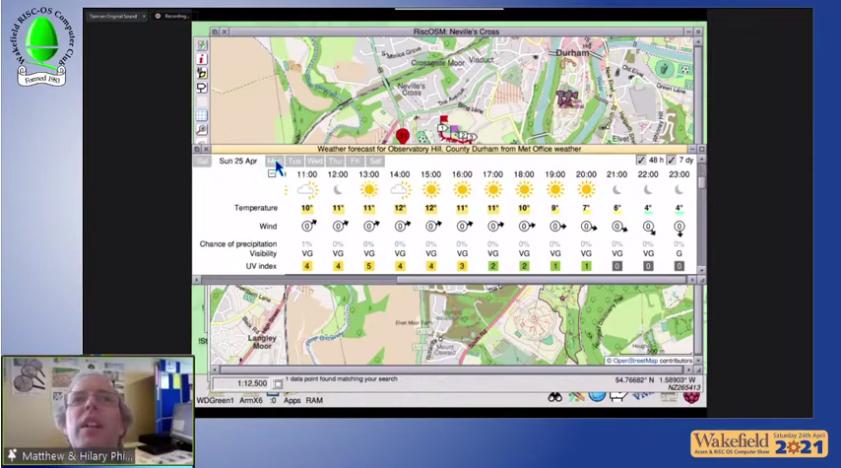
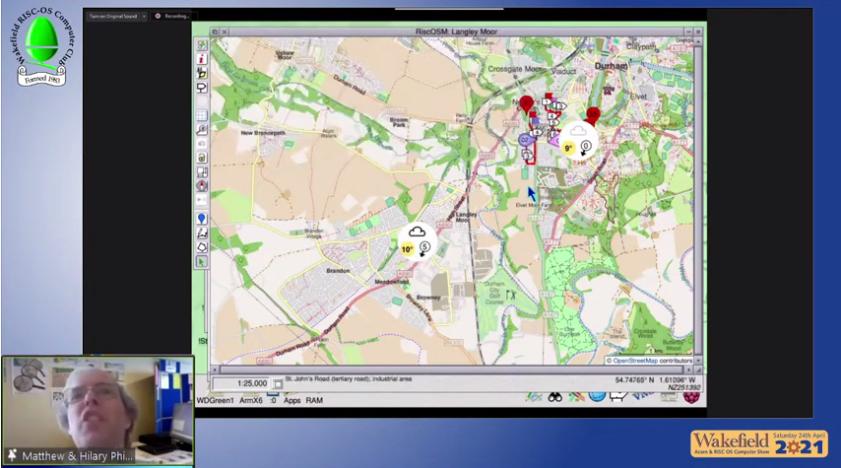
Impact now has an overview of the structure of the database. ImpEmail had also been updated - these two would be on the web site within a few days.
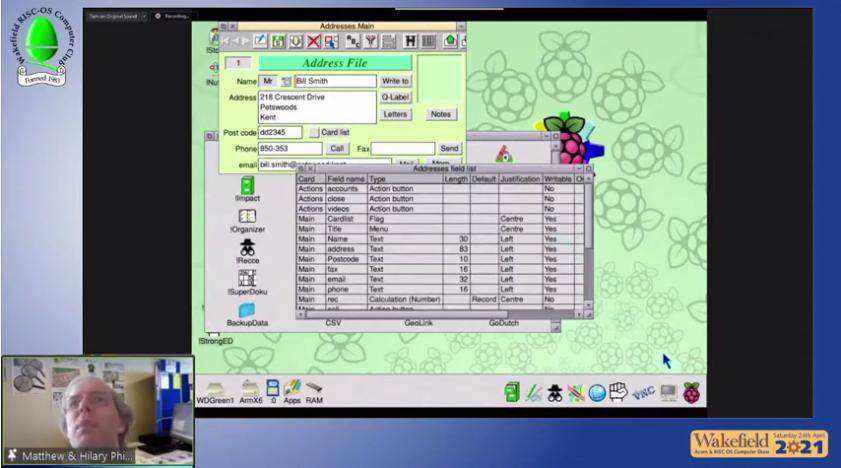
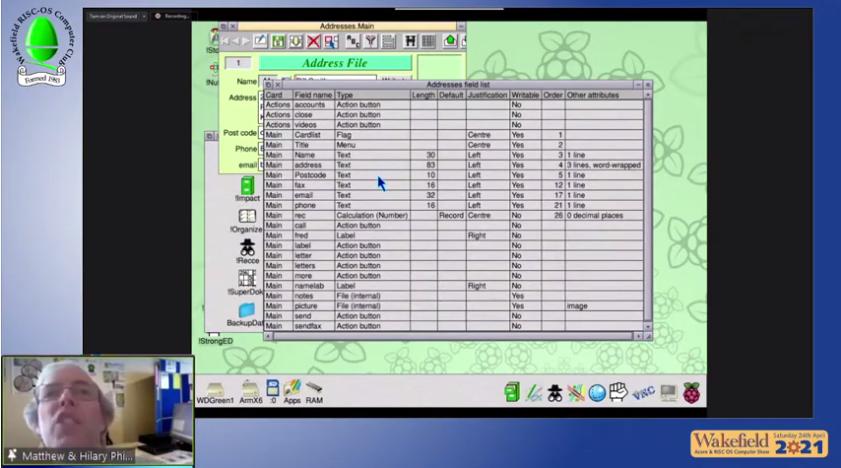
In response to a question, Matthew outlined the countries available for data download. Hebrew or Arabic are right to left for example and this is not supported by the Ruffel library.
1530 Elesar
"Elesar will be taking you on a tour of the flagship TextEase Studio applications, including some hot-off-the-press news. In addition we'll be taking a look at hardware solutions from addons that can be fitted at home to complete systems."
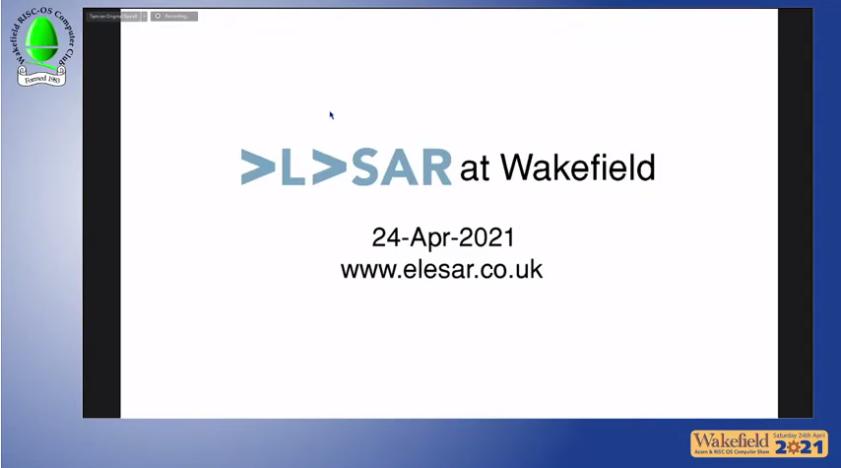
Rob covered some product updates from Elesar which he described as a four point turn. CloudFS had been updated to version 0.33 as shown.
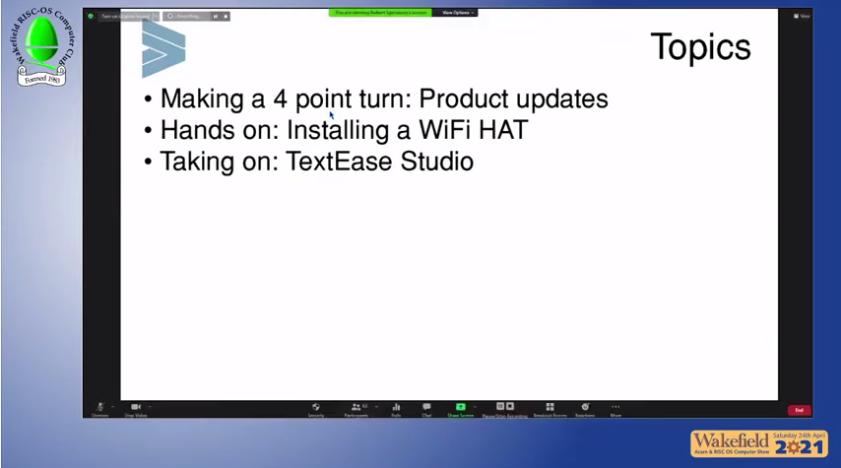
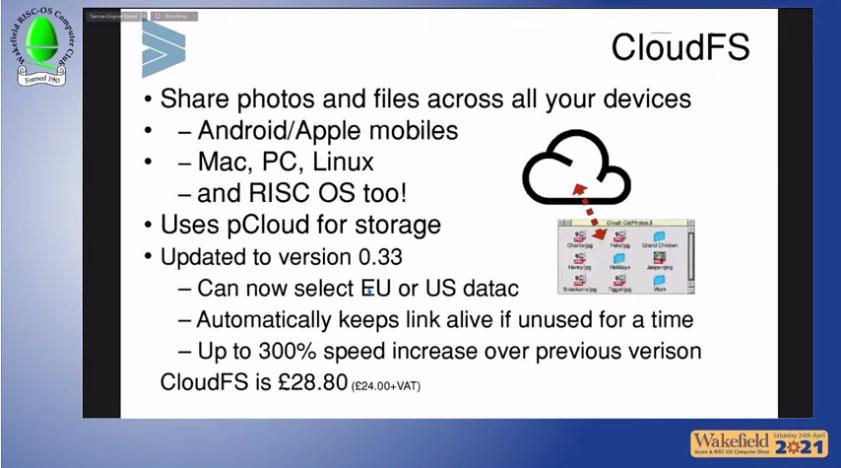
The accounting software, Prophet, had also been updated to version 4.08. If accounting software could be considered interesting, it now supports 'Making Tax Digital'.
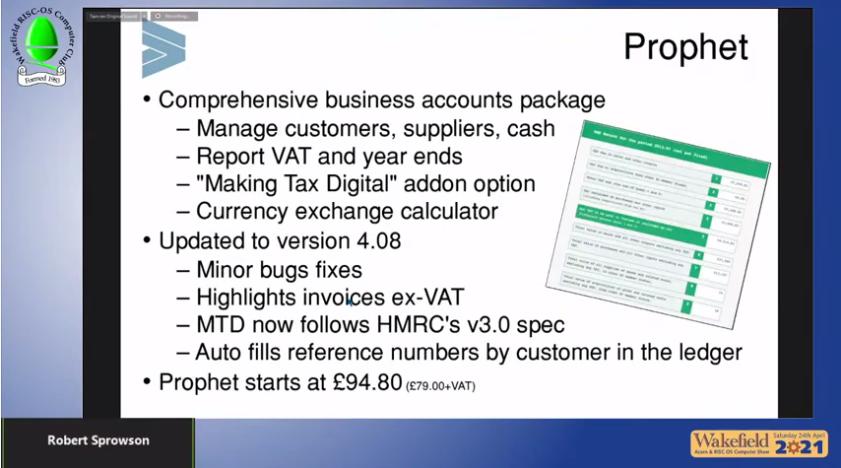
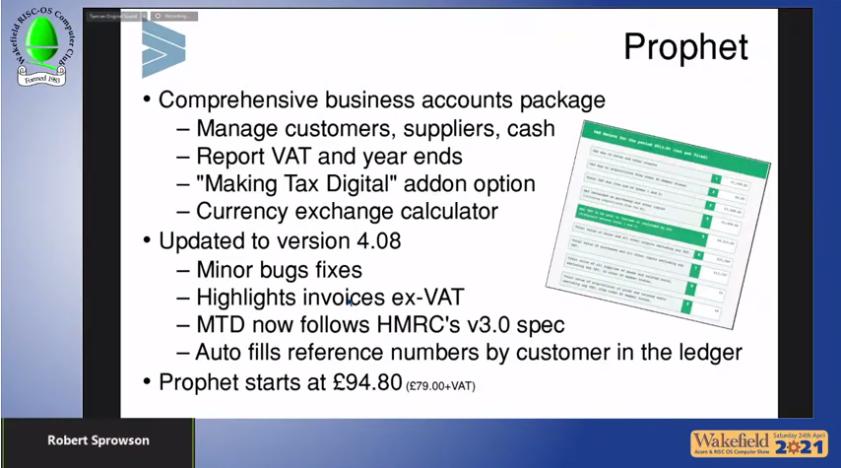
The WiFi Hat software had been updated as had TextEase, both to be covered in more detail below.
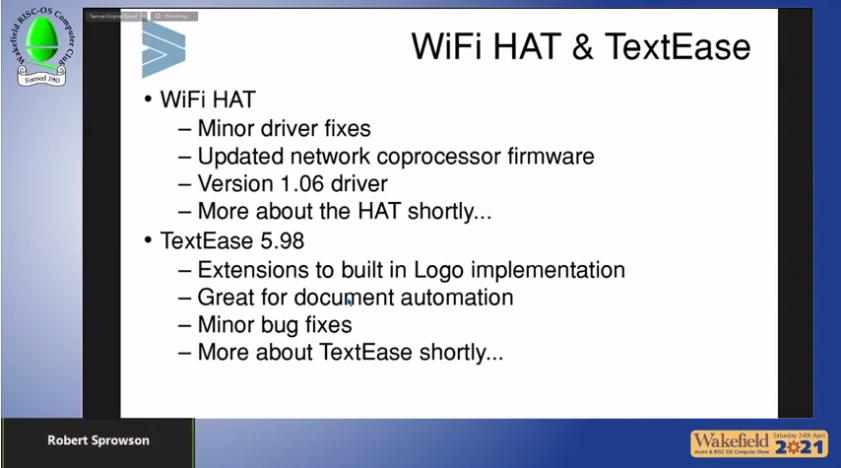
With his Elesar hat on (or T-shirt), Rob explained how to set up the WiFi Hat (Hardware Attached on Top) so that it appeared exactly as if it were a wired interface.
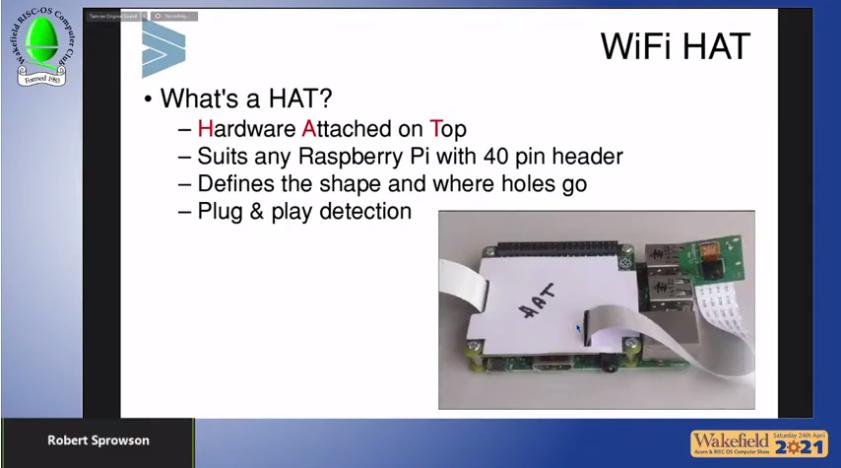
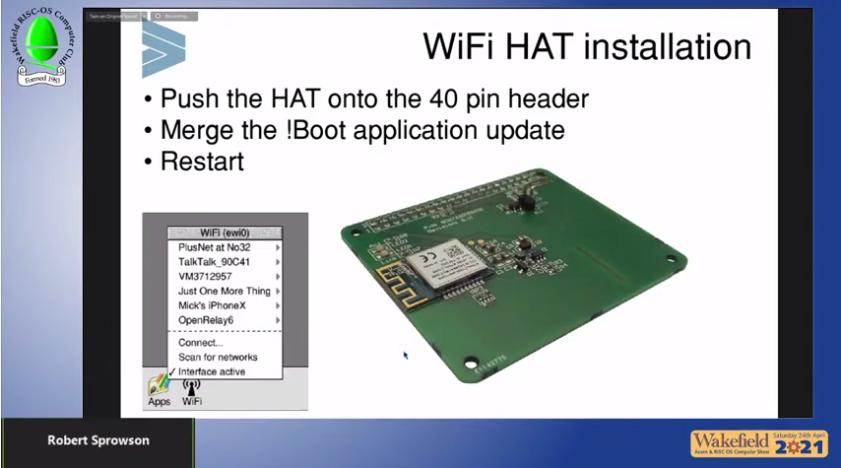
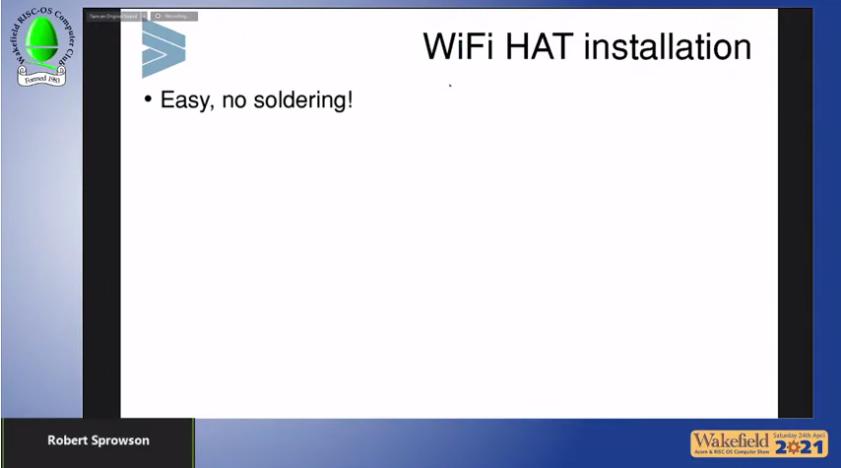
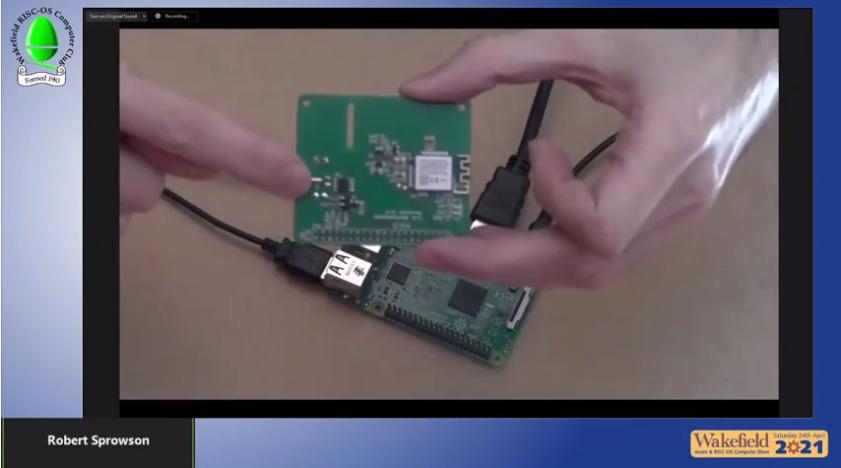
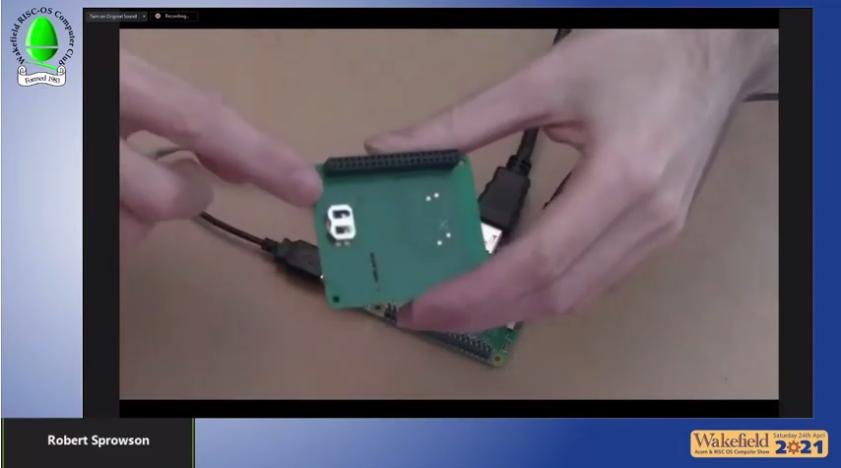
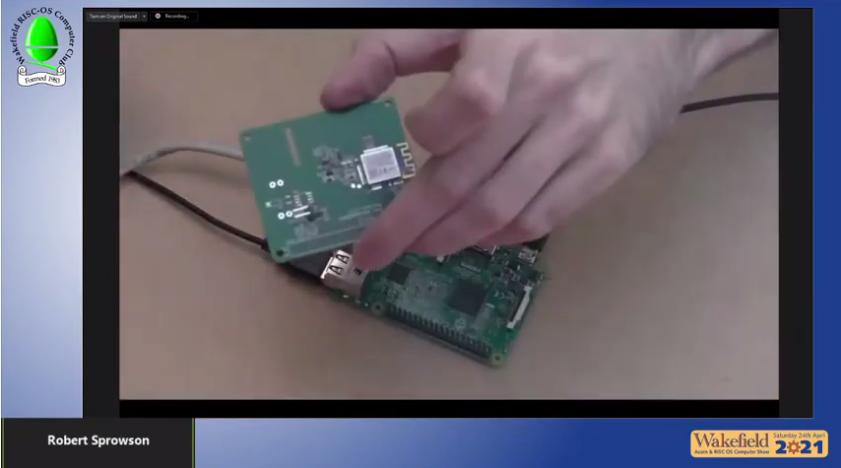
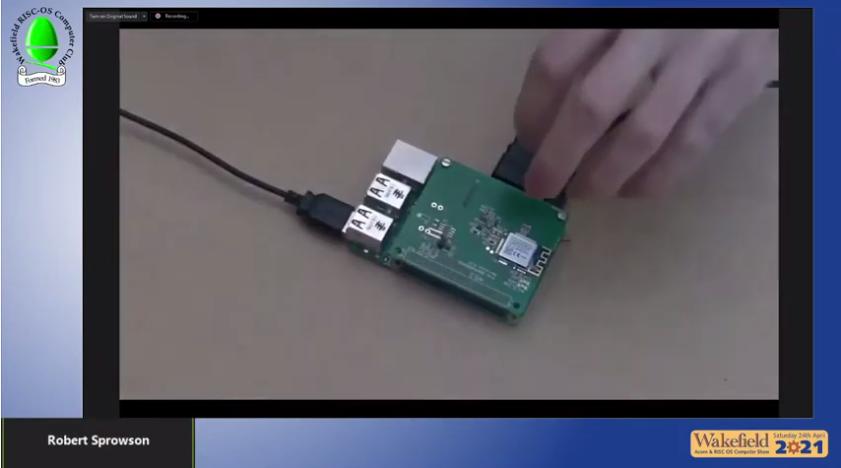
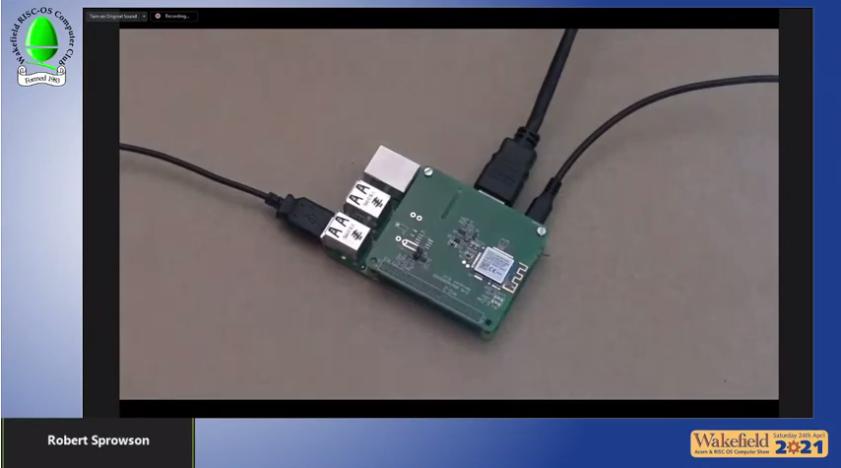
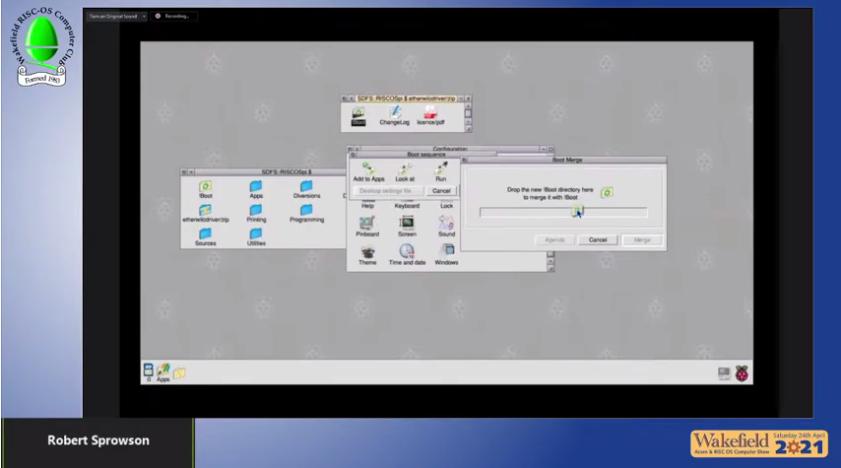
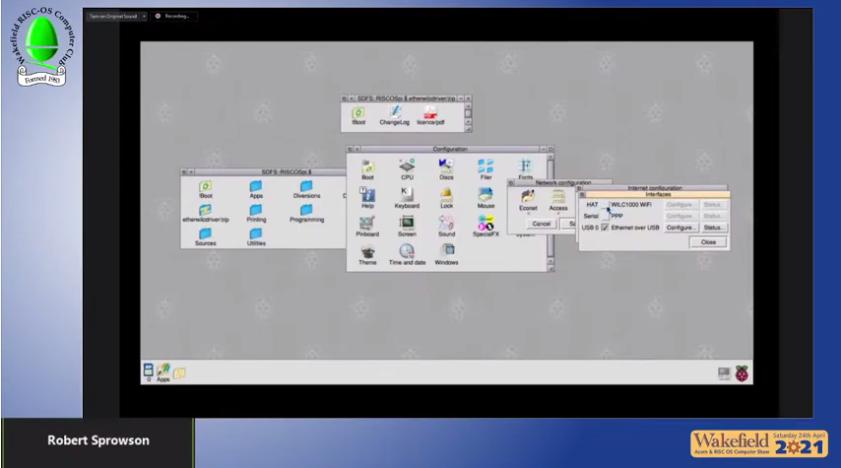
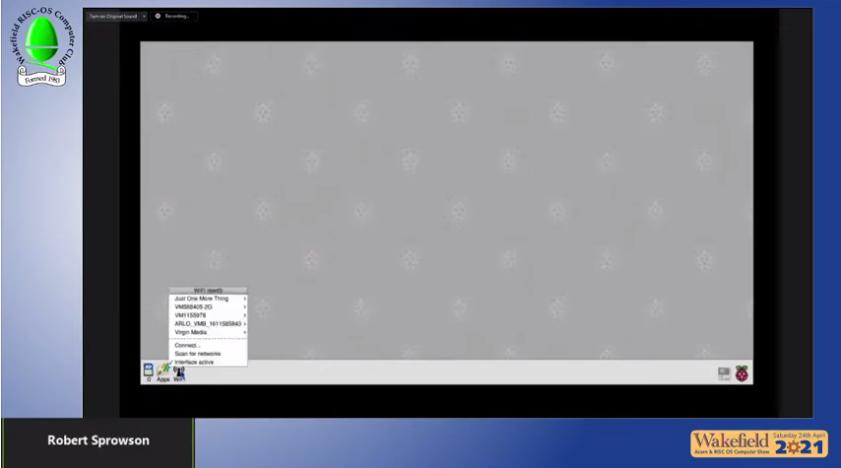
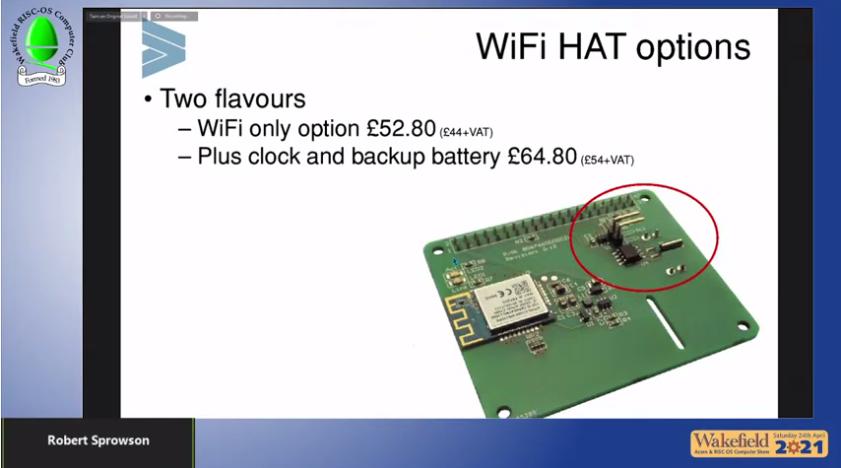
TextEase is a suite of six applications, well thought out for ease of use. Sprite and Draw files can use the OLE protocol to be edited externally in Draw or Paint. An updated printed User Guide of 153 pages for Textease was now available.
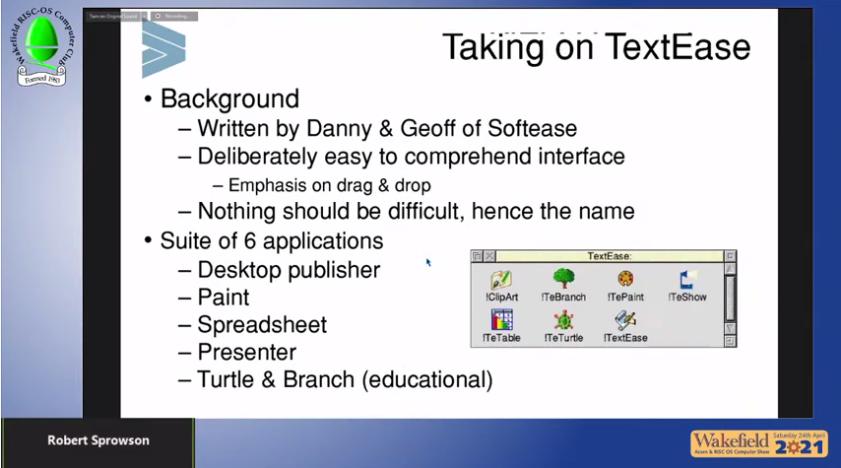
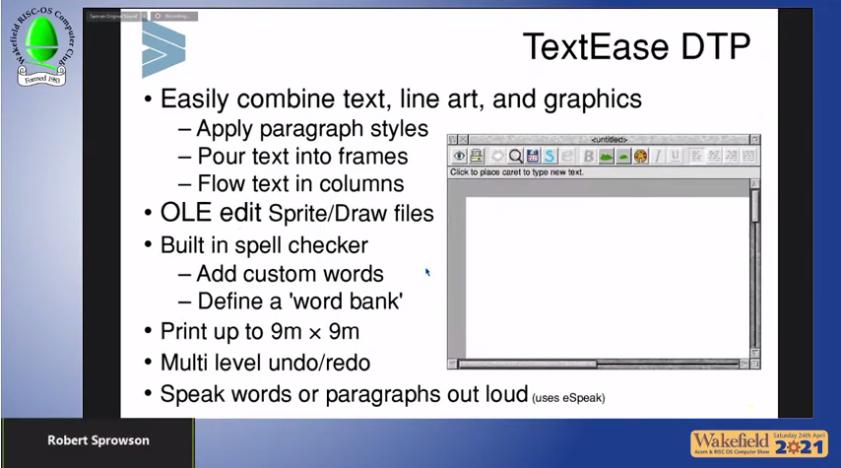
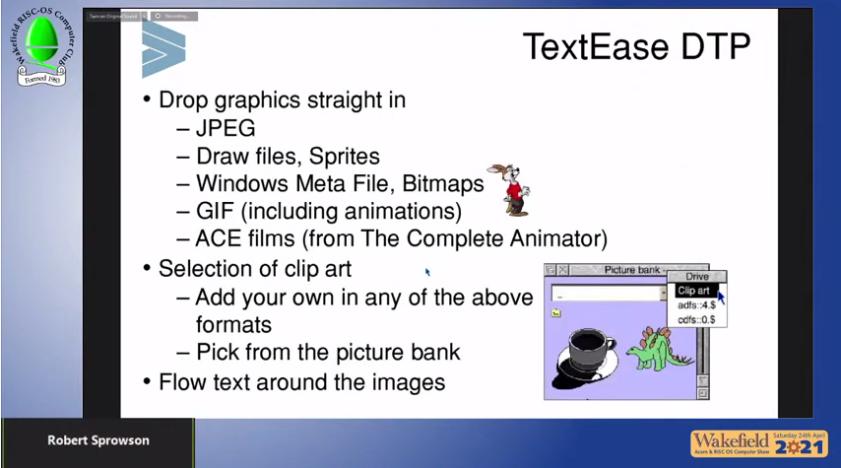
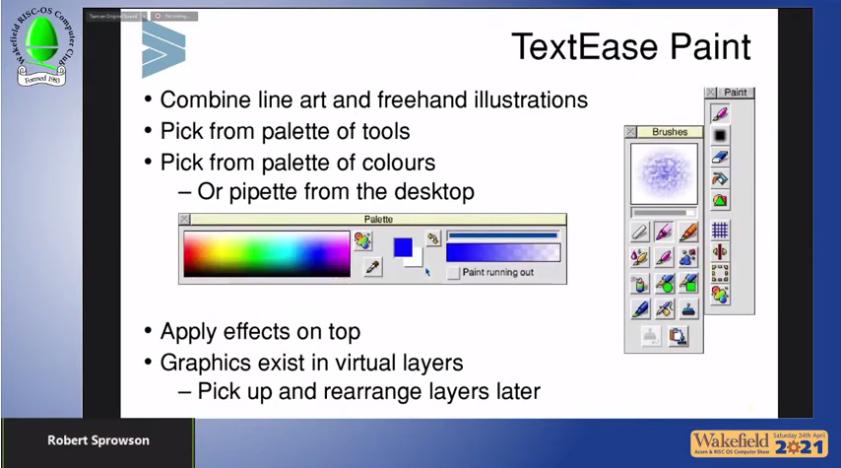

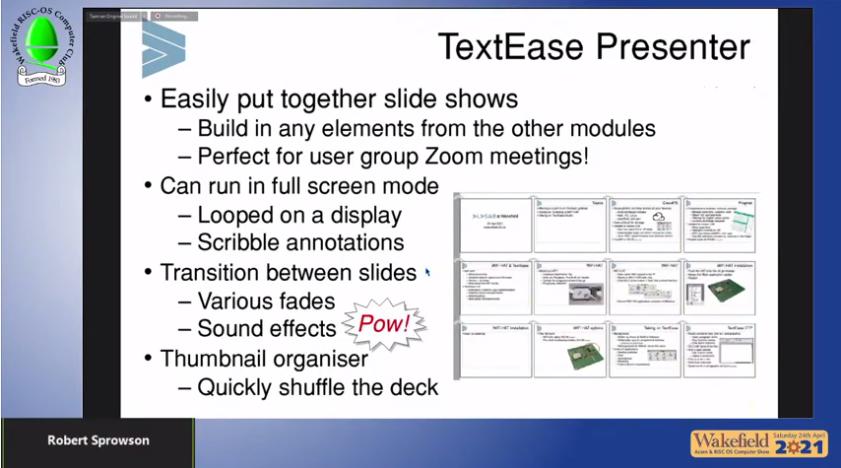
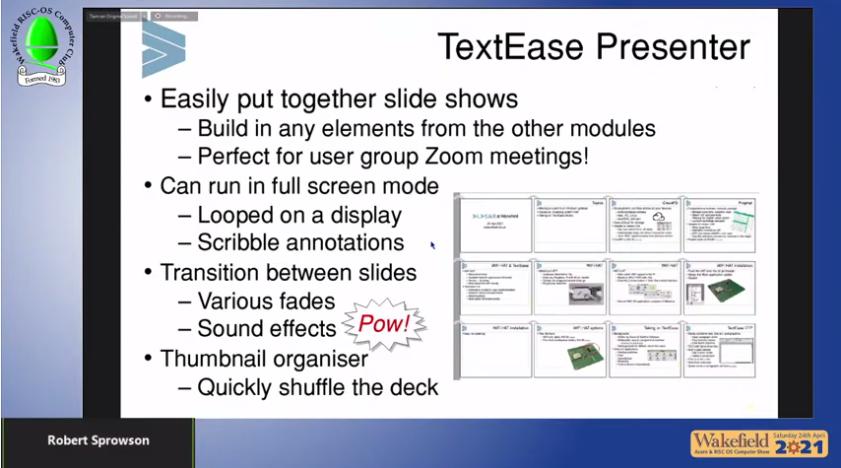
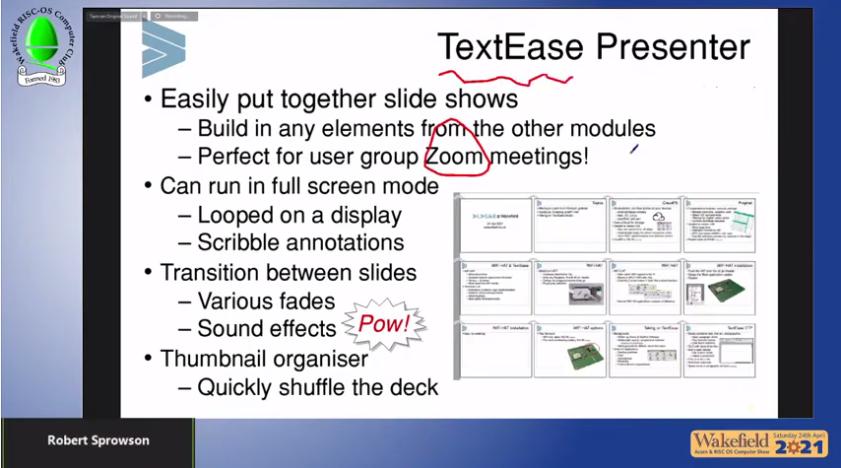
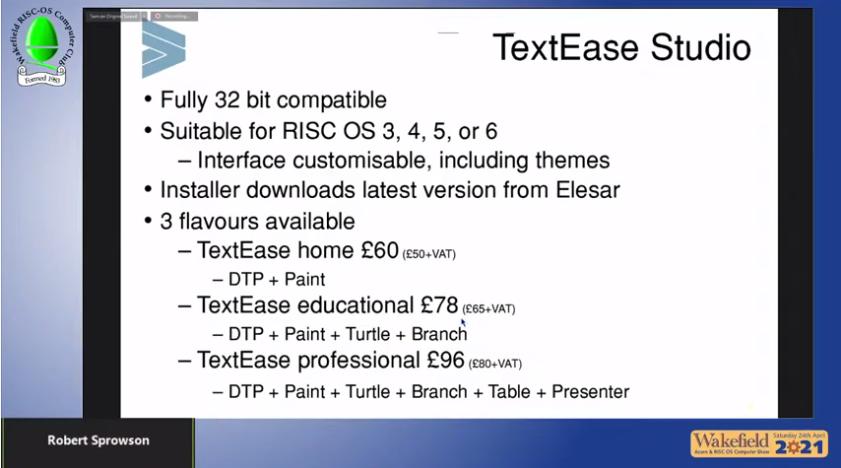
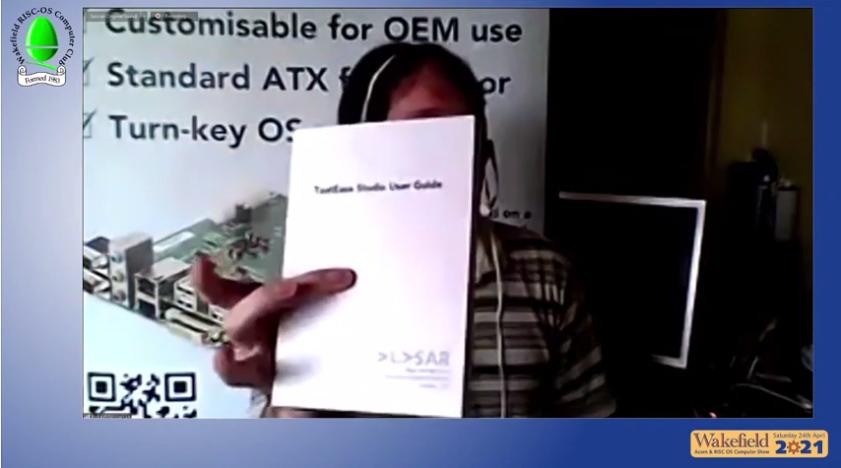
The 'paint' editor in Textease allowed effects such as a spray can rather than a simple line as in Paint. A textease document could be saved as HTML as a simple web page.
The WiFi Hat could, in principle, be used in 'IP forwarding' mode to act as a bridge to other RISC OS computers via the wired Ethernet socket but this had been tried for 10 years and may or may not work.
[to be continued]1600 CJE Micros
"Trading and Brexit update, recent, new and future products for BBC, A5000/RiscPC and RISC OS 5 systems."
1630 Soft Rock Software
"Vince Hudd is hoping to release an updated version of first game he released through Soft Rock Software. Hear about the origins of the game Escape from Exeria, and perhaps even see a demonstration of the new version"
1700 Cloverleaf Project
"Stefan from the Cloverleaf RISC OS Project will speak about the new Kickstarter 2 and the adopted offers. Funders will have more detailed choices to decide what they want to support specifically. "There are software options like a new programming IDE CodeCube and a new photo editing program ArtCube and more messenger clients for ChatCube like IRC or Signal. A !ChatCube mobile app for Android and iPhone is also on the choices list. There will be also two Cloverleaf RISC OS distributions that will include in the Plus version Fireworkz Pro and PDFmaker. "About OS improvements there is an offer of a 3D GPU support based on the open source project Panfrost for the ARM Mali GPU that can be found in the RK3399 SoC. "We promote also the exciting open source project from Paolo Zaino for an enhanced Desktop system. "About the hardware side of the project there a Cloverleaf Kitten based on the Raspberry Pi 4 for RISC OS beginners, the Puma RK3399 desktop PC and the RK3399 14” Laptop based on the PinePro. "The Kitten will be available directly. The RK3399 systems are still in development. "The Kickstarter will be released before the WROCC show."
1730 RISC OS Bits
"RISCOSbits will be showing off their range of cases and accessories for RISC OS machines, especially the Raspberry Pi. "They will also be showing off their new 'entry level' RISC OS system, PiAno, hosting a Pi 4 with added storage, encased in a matte effect black and white case with inbuilt cooling and extra storage. "They may also preview developments in their dual boot OS, allowing RISC OS and Linux to co-exist using only a software reboot, as well as their 'fruit-like' ITX solutions for the stylish desktop look."